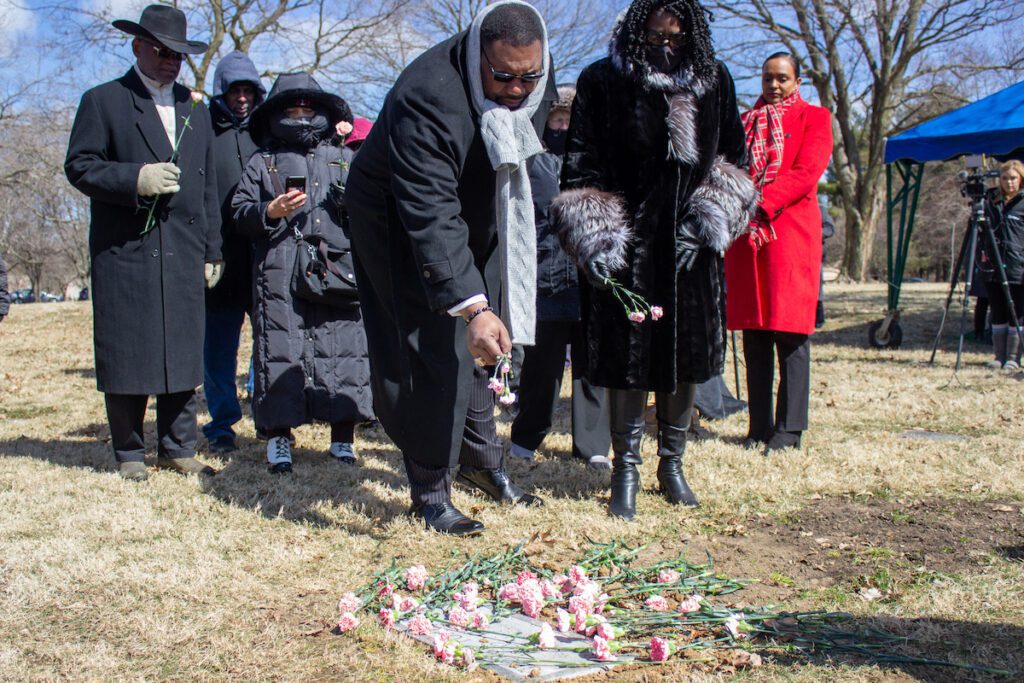The lynching of George Tompkins in 1922 is a reminder that those in power write the history. Because even with his hands tied behind his back, body hanging from a tree in Riverside Park, Tompkins’ death was written off as a suicide on his death certificate.
What is there to say 100 years after a man was lynched with no killers identified or prosecuted?
Rev. Clyde Posley called it bittersweet during a memorial March 12 at Floral Park Cemetery, where the Indiana Remembrance Coalition unveiled a new headstone at Tompkins’ unmarked grave.
“No person in this room met him physically,” Posley said to a group gathered at the funeral home, “but unfortunately we have met him nonetheless.”
The Marion County Coroner’s Office may have brought Tompkins as close to justice as what’s possible a century later by officially designating Tompkins’ death as a homicide.

Most of what is known about Tompkins comes from an article in the Indiana Daily News the day after his killing. (Though the Recorder certainly covered his death, the paper’s archives are missing from 1917 to 1925.)
Tompkins was born in November 1902 in Kentucky and had lived in Indianapolis for only two years before he was killed. At the time of his death, he worked at Fairmont Glass Works, which was east of present-day Fountain Square.
Tompkins’ body was discovered in the woods on the afternoon of March 16, 1922. He was 19 years old.
According to the Indianapolis Star, detectives believed Tompkins’ death was a suicide, but the coroner thought he was killed somewhere else and likely taken to the woods and hanged from the tree.
Rebecca Shrum, an assistant professor of history at IUPUI, cited two patterns of anti-Black violence in the early 20th century that can help make sense of what happened.
First is the number of lynchings whites declared to be suicides: about two dozen, according to the Civil Rights and Restorative Justice Project at Northeastern University. Second is the emergence in the Midwest of “underground lynchings,” which were carried out by smaller groups of whites because public lynchings perpetrated by larger groups brought negative publicity.
“Whites in Indianapolis committed two violent atrocities against Tompkins,” Shrum said. “They took his life, and then they erased the memory of the event and replaced it with a lie.”

The Equal Justice Initiative counts 4,743 lynchings in the U.S. between 1882 and 1968, though historians accept the true number is higher than that and may never be known. There were 14 Black people lynched in Indiana during that time, according to the University of Missouri-Kansas City School of Law.
“The truth is, after the Civil War, Indiana, an anti-slavery state, still attracted people who thought it was their birthright to harm, to kill others who didn’t think like them, who didn’t look like them,” said Karrah Herring, chief equity, inclusion and opportunity officer for Gov. Eric Holcomb’s office.
Mayor Joe Hogsett talked of institutional responsibility. It was city officials, after all, who in 1922 said Tompkins died by suicide. Hogsett said an invocation would typically call upon God, but he went a different route.
“Today, though we certainly call for God at this solemn memorial,” he said, “my invocation is directed at a more Earth-bound authority: the city of Indianapolis itself.”
Attendees cheered Tompkins’ new death certificate, followed a procession to his gravesite and laid flowers on his flat headstone.
Posley talked about the responsibility today of standing up for the truth, as difficult as that can be.
“It is a natural tendency among many of us to destroy what we fear most,” he said. “That fear, that control, can be stopped by people banding together to simply allow a civil, equal ontology for all cultures.”
Contact staff writer Tyler Fenwick at 317-762-7853 or email at tylerf@indyrecorder.com. Follow him on Twitter @Ty_Fenwick.





